Steven Defour had a long and successful playing career at the highest level of football. The Belgian started his career at his hometown club KV Mechelen, before eventually playing for Genk, Standard Liège, Anderlecht and Antwerp in his native Belgium. The retired midfielder also played in Portugal for FC Porto, as well as Burnley during their spell in the Premier League.
After retiring from playing, Defour moved into management, with the 34-year-old being made Wouter Vrancken’s assistant at Mechelen for the 2021/22 season.
When Vrancken left to join Genk at the end of last season, Defour stayed as the assistant when the club brought in Danny Buijs. The Dutchman’s spell in charge was rather short, with the club sacking him after he only picked up 3 wins from his first 11 matches in charge. The club then gave Defour the reins, and he has excelled with the opportunity presented to him.
The 34-year-old has dragged the club to virtual safety in the league, as well as guiding them to the Belgian Cup final, where they will play Antwerp.
This tactical analysis piece will take a look at the former Burnley midfielder’s tactics with the Belgian side, looking at what he has done to turn their fortunes around since taking charge.
Preferred formations and style of play
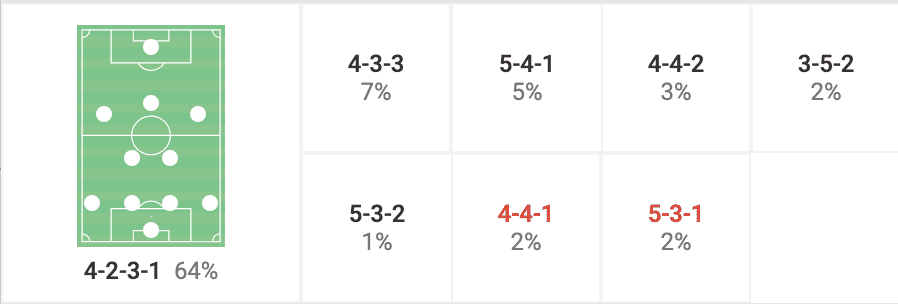
The image above shows that Steven Defour has normally opted to set his side up in a 4-2-3-1 formation the majority of the time. However, this will often shift into a 4-3-3, with the two wide midfielders pushing up onto the opposition defence’s last line to press them, with the #10 dropping slightly deeper into midfield and lining up close to the double pivot.
The 34-year-old Belgian looks for his side to play an attacking brand of football, and they will continue to put their foot on the gas regardless of the opposition or what the scoreline is.
They look to generate chance creation from the wide areas, with Mechelen looking to move the play wide when in attacking moments, which allows them to create overloads in these wide areas using the advancing runs of the fullbacks. When it comes to build-up phases of play, they look to normally play it long, again trying to move it into the wide areas, but Defour’s side will also play it short at times as well, with one of the sixes dropping-in to support.
They look to defend compactly, with the formation becoming a 4-3-2-1 at times in defensive phases to be more narrow centrally, with Mechelen allowing the opposition to play wide where it is less likely to hurt them. As this tactical analysis progresses, we will analyse these concepts of play in more detail when it comes to Steven Defour’s Mechelen.
Attacking style of play: chance creation from wide areas
When it comes to how Steven Defour likes his Mechelen side to attack, the Belgian team look to exploit overloads in the wide channels, which allows them the ability to create chances from these areas. They also like to play the ball long into these areas to the wingers, usually Nikola Storm and Kerem Mrbati, who then look to send crosses into the box from the wide areas, or drive into the penalty box from these positions when they are in possession.
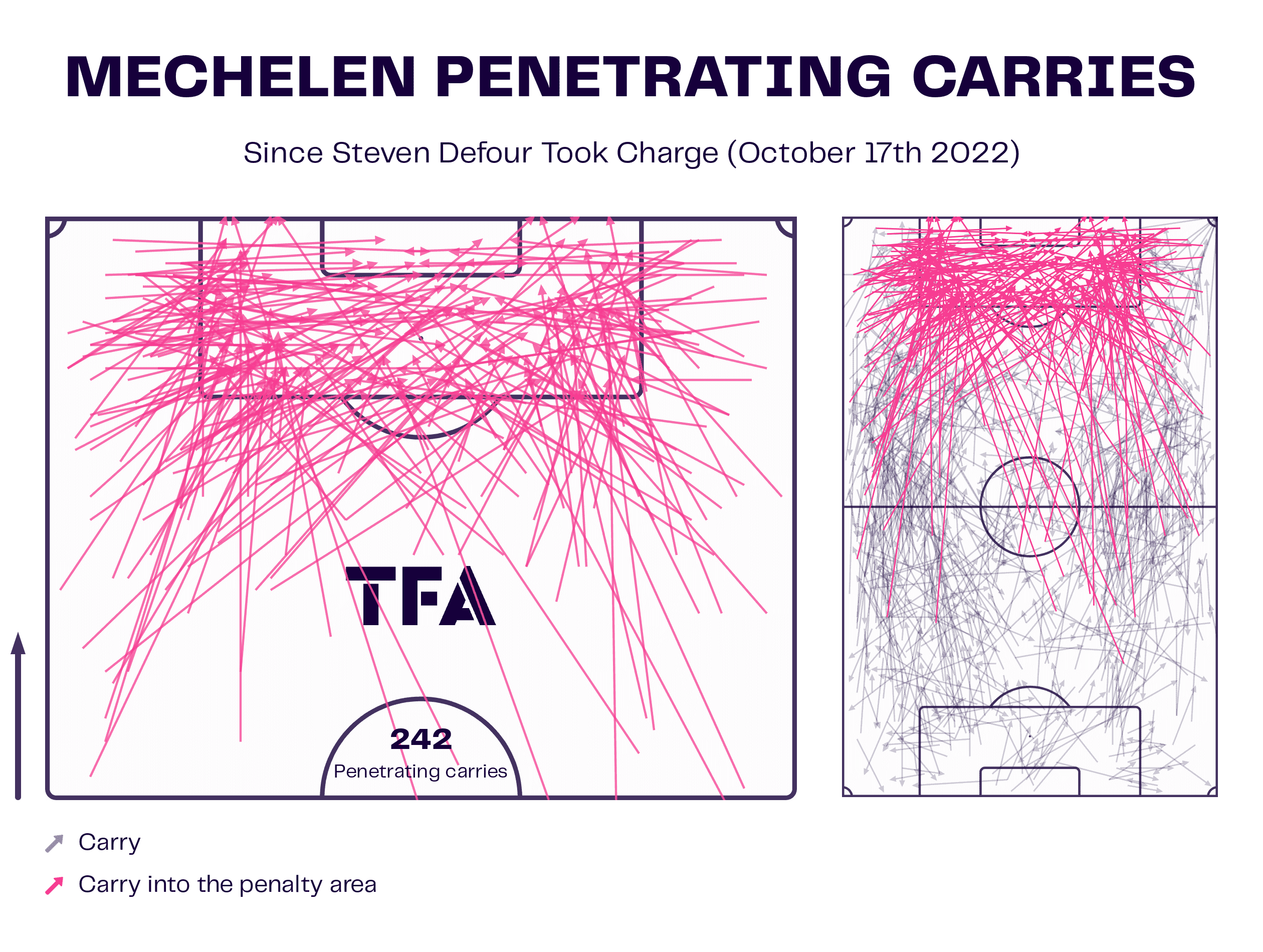
The data viz above shows the penetrating carries for Mechelen since Steven Defour took charge after the dismissal of Danny Buijs. The Belgian side have had a relatively high number of penetrating carries since the appointment of the 34-year-old Belgian, with a high frequency of 242 originating from the wide areas.
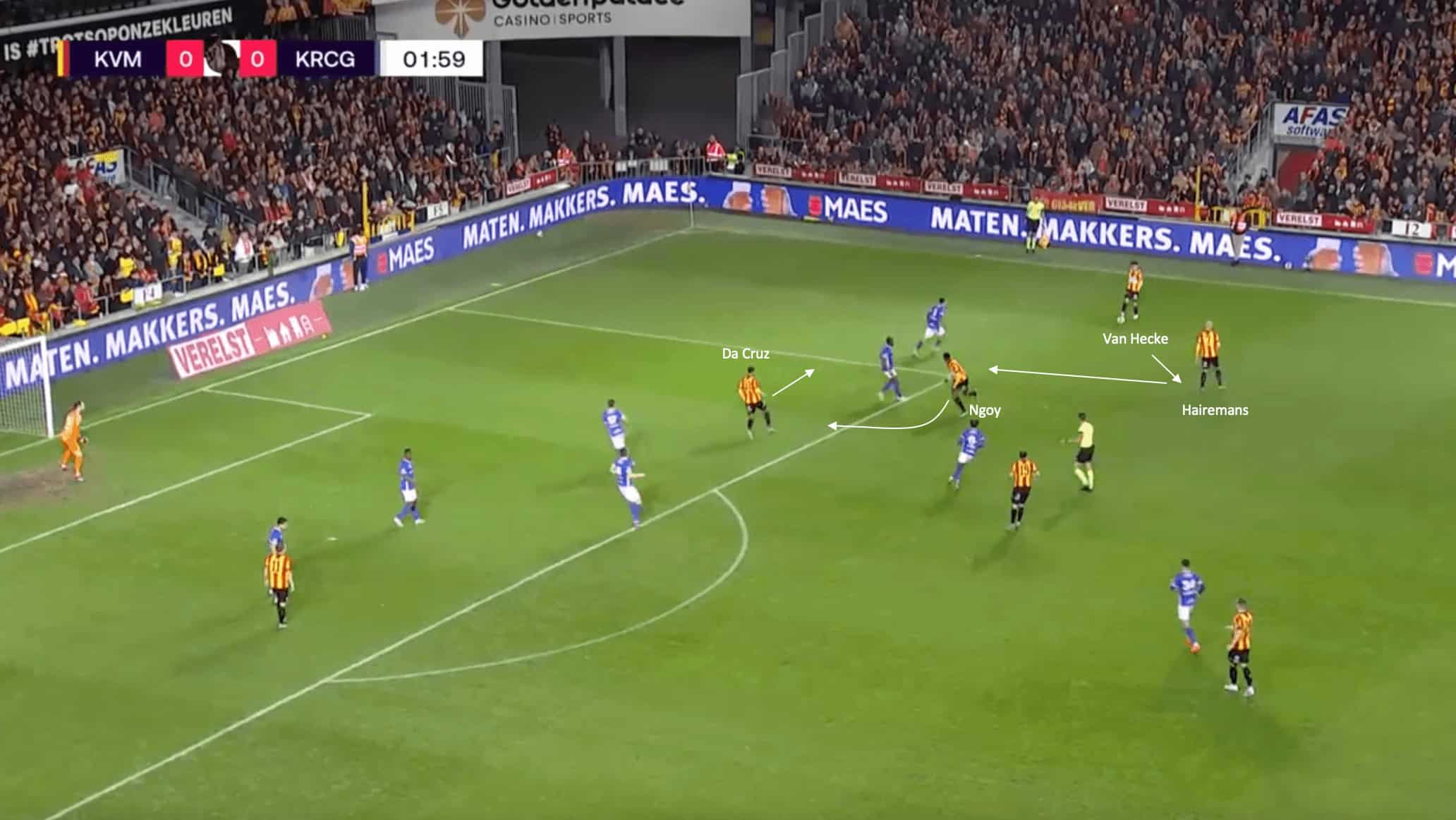
The image above shows an example of Mechelen creating an overload in the wide channel to progress the ball into the penalty box, which leads to a chance for the Belgians.
As already mentioned, Steven Defour looks for his side to have numerical superiority in the wide areas, with the phase of play above being a great example of this. In this attacking phase against Wouter Vrancken’s Genk, fullback Jannes van Hecke pushed high and into an advanced position, keeping the width with the winger tucking inside centrally. Geoffry Hairemans, one of the three central midfielders, also drifts into the wide channel to support, with striker Julien Ngoy also moving wide to initially create a 3v2 against the Genk defenders. Finally, Alessio da Cruz has pushed into an advanced position as well from a deeper midfield position, with this giving Mechelen a 4v2 in the wide channel.
As the play progresses, van Hecke plays the ball centrally to Hairemans, who is able to find da Cruz, with the midfielder checking into the pocket of space behind the two Genk defenders. The run of Ngoy from out-to-in works as a decoy, with the Genk defenders stepping up to Hairemans, which allows him to play through them to da Cruz. The Mechelen player is able to turn and drive towards the byline but unfortunately is dispossessed by the Genk defender, who is able to track back. Though it does not lead to a direct shot on goal, it still demonstrates the type of attacking play that Defour looks for his side to utilise.
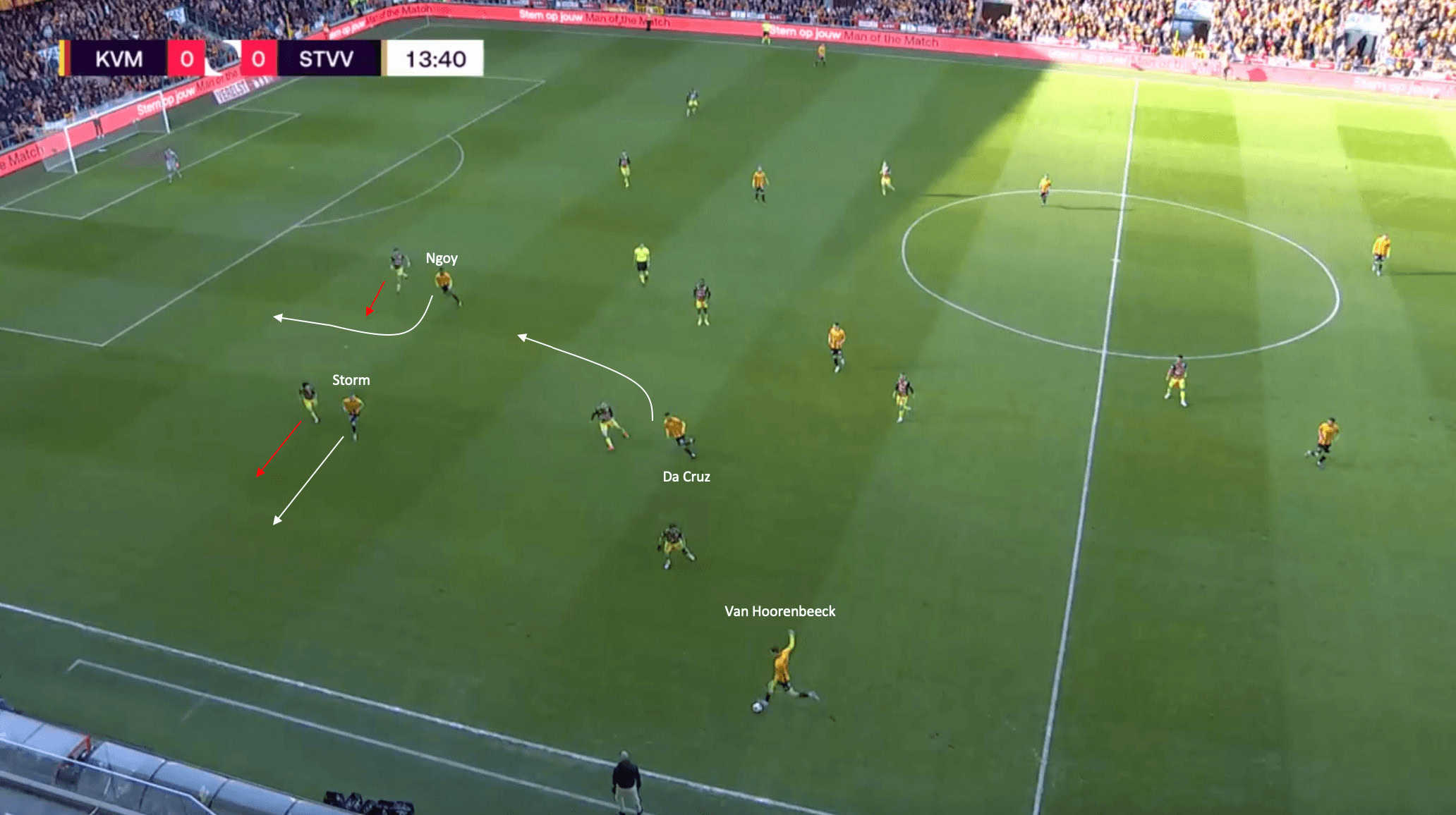
Another way that Defour’s side looks to create chances from wide areas is movement off the ball to drag opposition defenders out and create space in the half spaces and in behind. This attacking phase of play from their recent match against Sint-Truiden shows an example of this. As we can see, Mechelen do not have numerical superiority in the wide space, with Sint-Truiden able to commit enough defenders to make it numbers even.
So, to be able to create the space to generate chances, Defour’s side instead looked to use off-the-ball movement to open up spaces. As is commonplace for the 34-year-old’s attacking system, fullback Alec van Hoorenbeeck has moved into an advanced attacking position, holding the width and looking to play vertically. With the passing lanes blocked, Nikola Storm drifts wide, pulling the fullback along with him. This opens the passing lane for Ngoy to move into, with the striker able to receive possession from the fullback after moving into the position Storm was just occupying. While this is happening, Alessio da Cruz is able to get onto the blind shoulder of the defenders and make an unmarked run into the penalty box.
Unfortunately, the ball does not find him and the Mechelen attack breaks down. However, this also shows the tendency for the deeper lying midfield players to get involved in the attacking side of the game, something that Steven Defour also enjoyed doing often during his playing career.
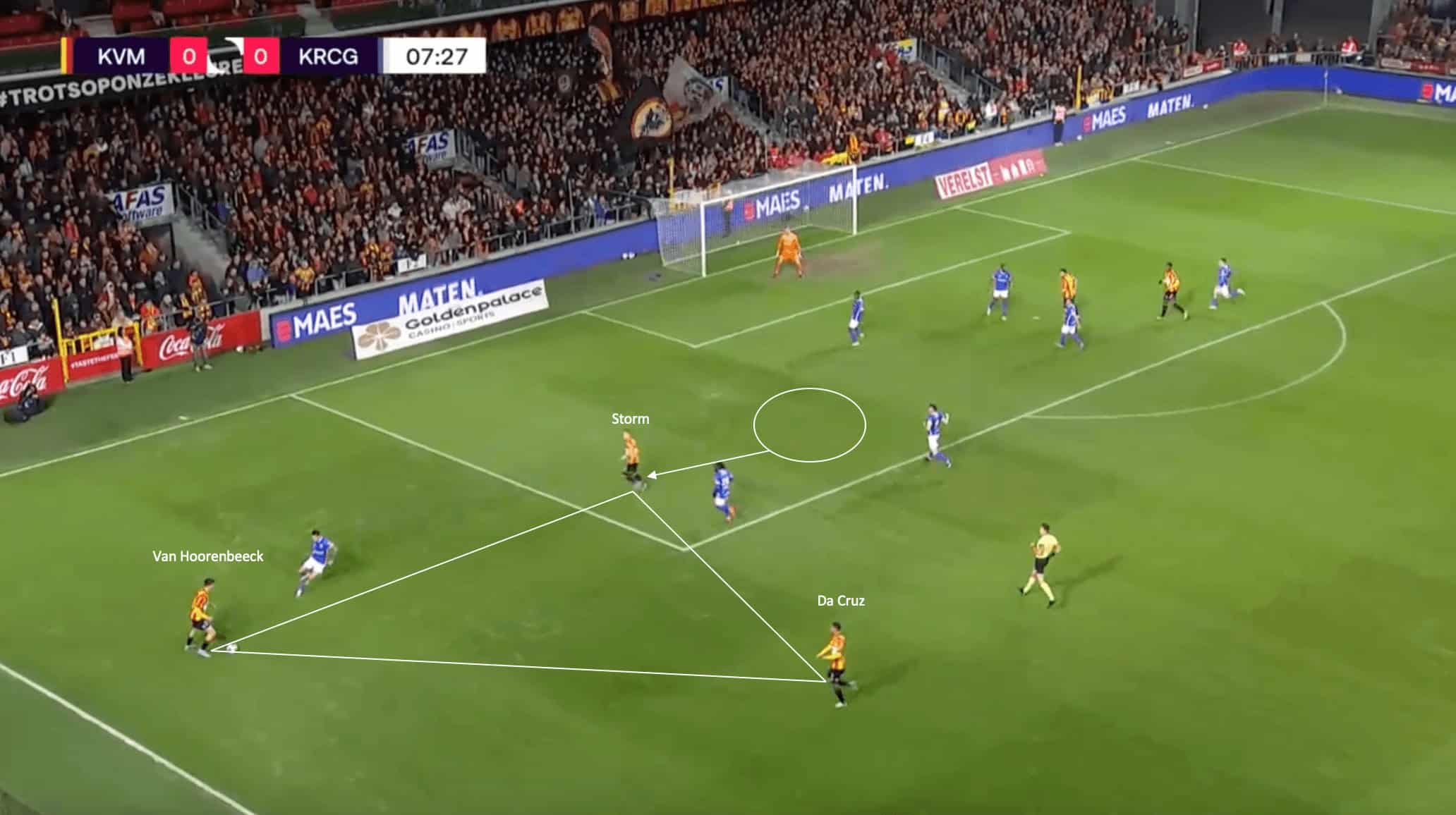
The example above again shows the ability for the Mechelen attackers to spot and take advantage of an overload opportunity in the wide channel to generate chances. In the phase of play above against Genk, the ball is in the possession of the fullback, who is again operating in a very advanced position to attempt to create an advantage in the attack. Da Cruz has also shifted over to be an option, along with Storm, who has moved wide from a more central position, which creates numerical superiority and an overload for Steven Defour’s side.
Storm’s movement also is able to drag the defender away from da Cruz in a more central position and this allows van Hoorenbeeck to play the ball inside to him. With him now having the space to drive forward, he does, with his ensuing shot likely being on target and troubling the goalkeeper if it was not blocked by the defender. As this section has shown, Steven Defour’s side have been very successful at creating chances from the wide areas, and it comes down to the principles that have been mentioned.
Defensive style of play: physical but looking to defend in a compact shape and bait the opposition to one side
When looking at the defensive style of play that Mechelen have under Steven Defour, and more specifically, his defensive principles, a couple of things that stand out are the physicality his side defend with, as well as their compact shape when forced to sit back.
One interesting metric to look at when it comes to Mechelen’s defensive style of play is challenge intensity. The Belgian side have the third-highest challenge intensity in the league with 6.4, which looks at duels, tackles, and interceptions per minute of opposition possession. They also rank in the top half when it comes to yellow cards, with their 55 this season being one of the lower numbers in the league.
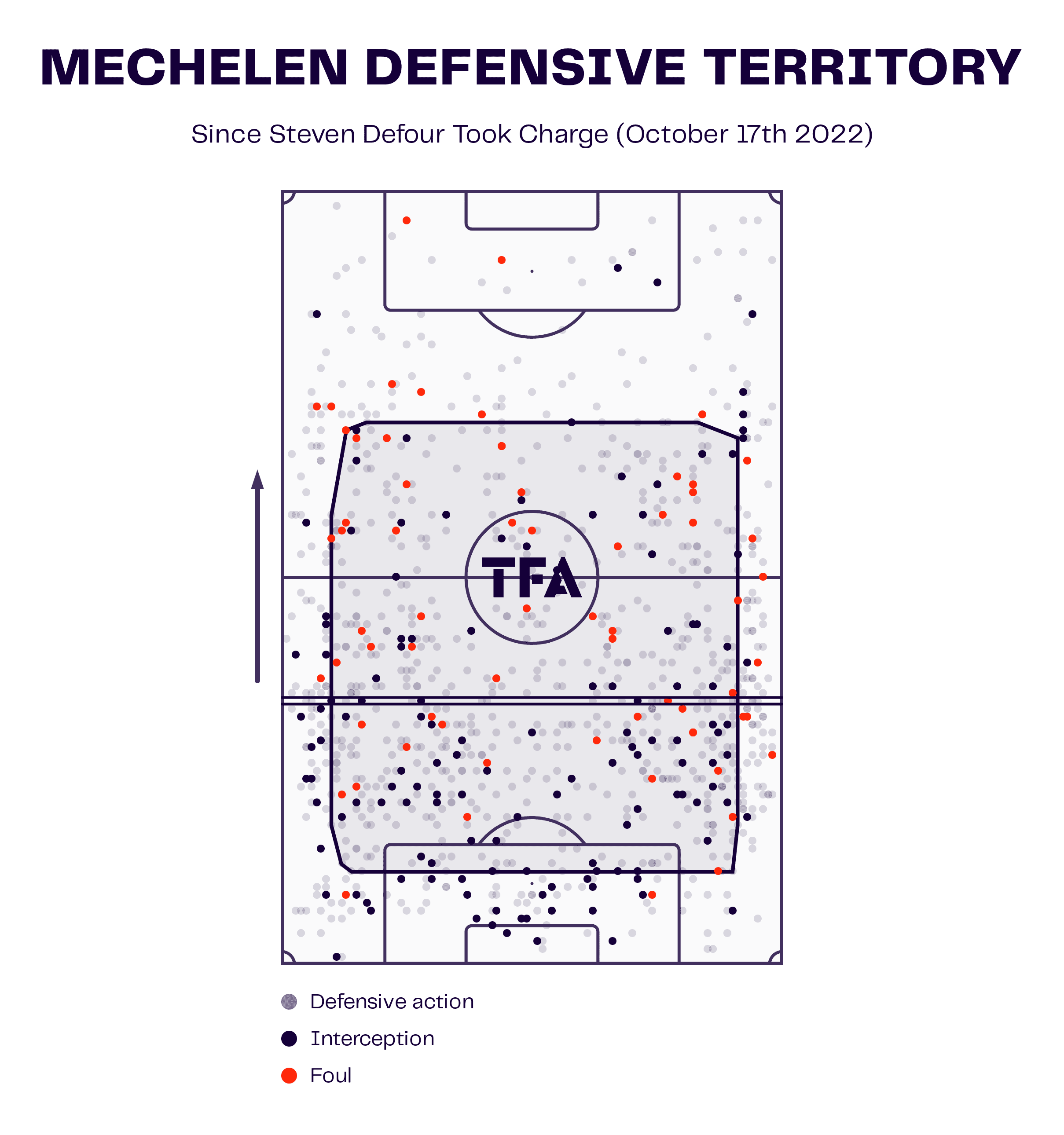
The data viz graphic above shows Mechelen’s defensive territory since Defour took charge. It also shows the average recuperation line of possession from Mechelen, which is just about in the defensive third of the pitch. While they are rather aggressive when it comes to winning possession back, they will look to defend in either a compact 4-2-3-1 or even 4-3-2-1, with the wingers tucking inside centrally.
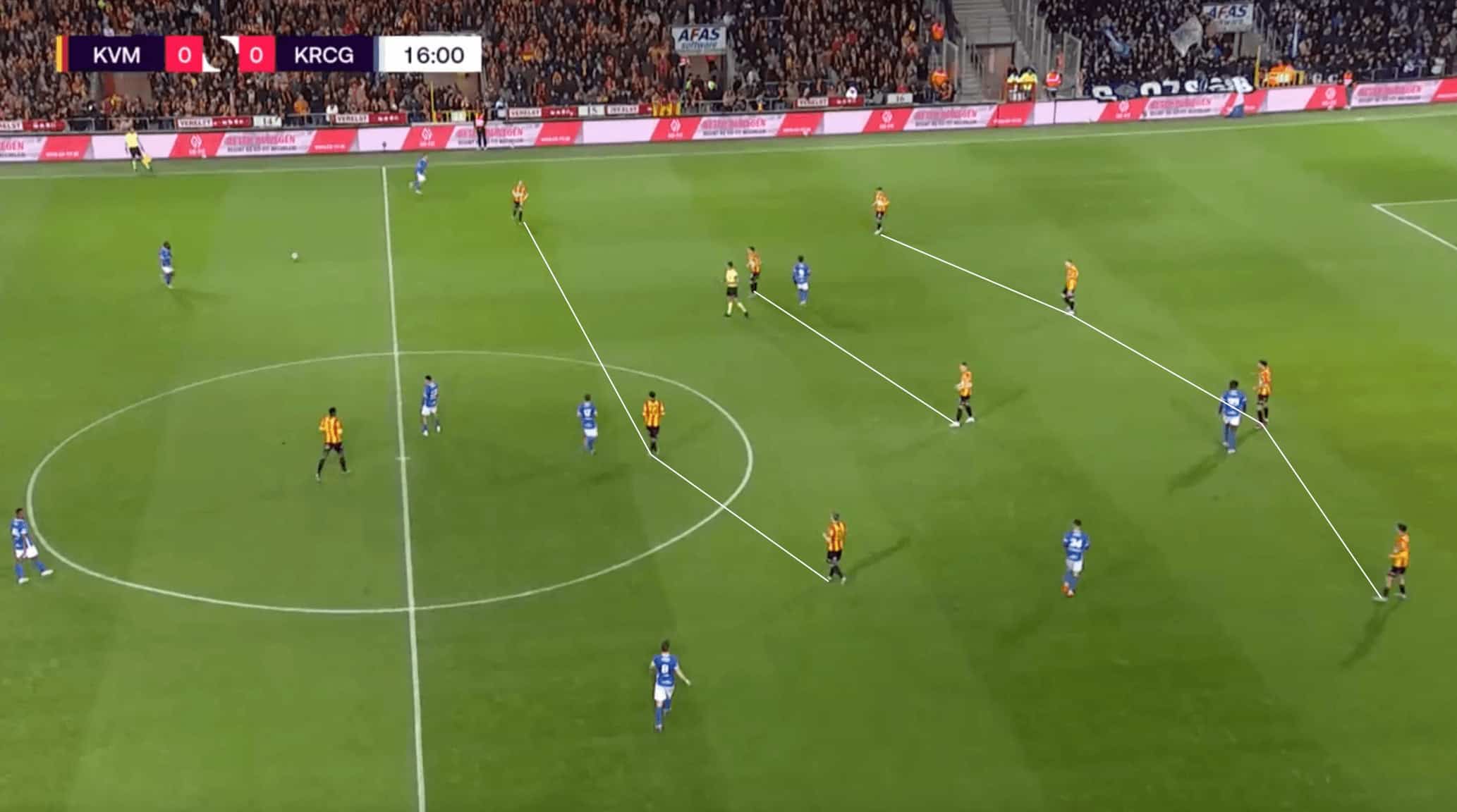
The image above shows an example of the shape that Mechelen looks to sit in when the opposition are in possession. While Defour does like his side to press, they don’t look at all times, instead opting for compact defending where they can win possession back.
As we can see, they have dropped into a 4-2-3-1 shape, with the wingers dropping, leaving the striker all alone up top to put pressure on the centre-backs when they receive possession. What they look to do is be patient defensively, before eventually pressuring the ball to one side, which then triggers the Mechelen defenders to put pressure on the ball and attempt to win it back.
The next example shows a bit further in this attacking possession for Genk and looks at what Mechelen look to do when the ball is finally forced to one side.
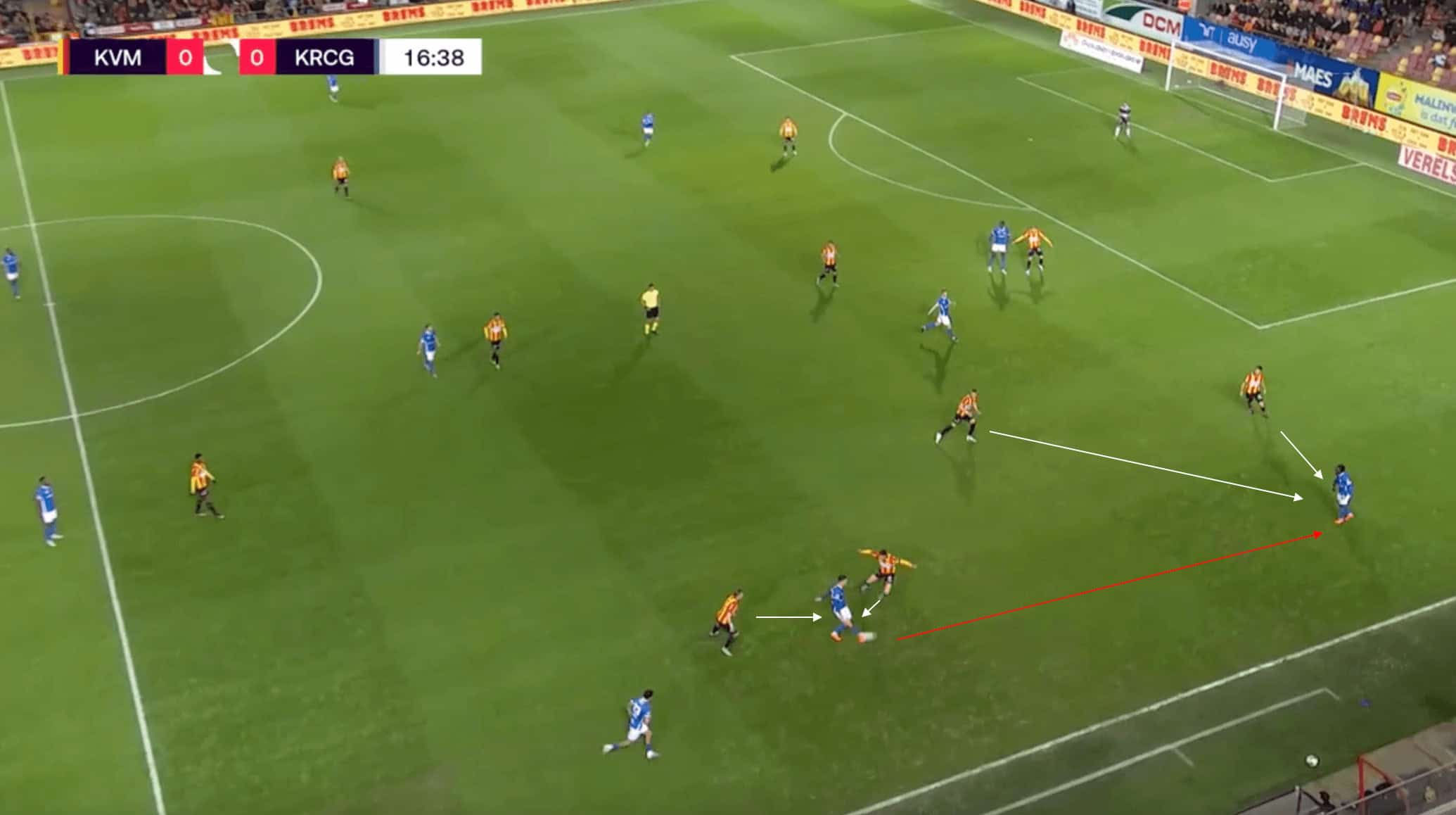
The image above shows the same phase of play, this time with Genk getting impatient swinging it side-to-side and playing vertically instead. Genk eventually played the ball forward to Manchester City-linked Bilal El-Khannous, who looks to turn inside but is not able to due to the movement of the Mechelen defender to trap him to the outside. This means the Moroccan’s only option is to play the ball forward to the winger, who is immediately closed down by two defenders as he receives possession. As a result, he miscontrols the pass and it goes out of play for a Mechelen throw-in.
Defour’s tactics of defending patiently before being aggressive when the moment is right allows the Belgian side to conserve energy from a defensive standpoint, allowing them the ability to stay aggressive in their attacks as the match progresses and enters the latter stages.
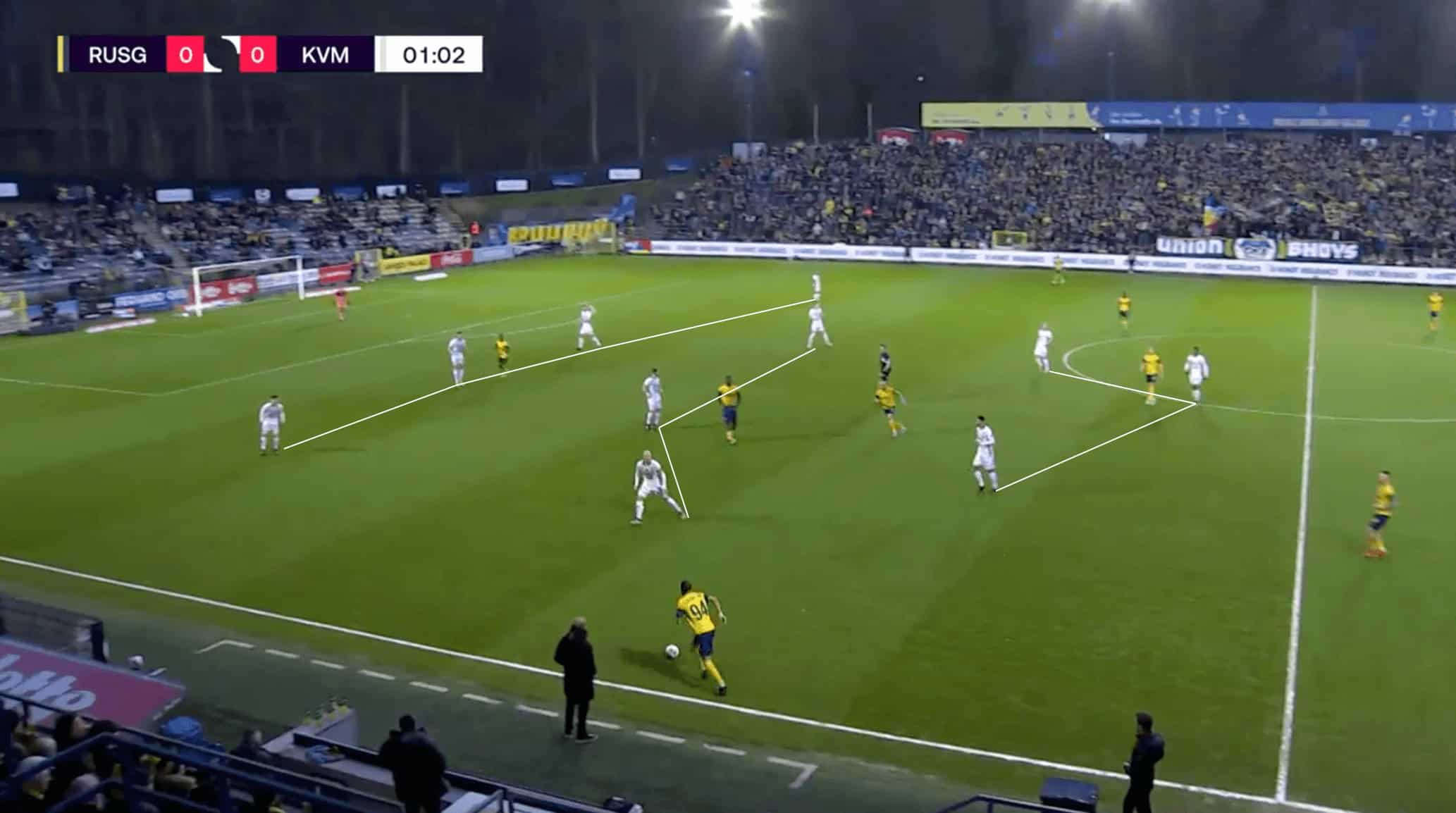
The image above shows the defensive shape that Mechelen opted to go for against Union Saint-Gilloise, with the formation being a 4-3-2-1 defensively. This allows the Belgian side to be very narrow, essentially negating all space centrally and forcing the opposition to play wide, which is what Mechelen looks to bait their opposition into doing.
This phase of play is a perfect example of that. The USG wingback is in possession and has space to drive forward centrally, which he does. The striker looks to come across and in front of the Mechelen defence to receive in between the lines. However, the closest central midfielder to the ball, the fullback, and the right centre-back all shift over as well, creating a defensive overload. As the pass is played vertically, the Mechelen fullback is able to intercept the pass and begin a transitional moment for Steven Defour’s side.
This section has been able to illustrate what Steven Defour’s principles from a defensive standpoint are for his Mechelen side. Though they look to defend relatively compactly, they also look to bait the opposition into playing wide to one side, which allows them to either create an overload and have numerical superiority defensively or quickly close down the opposition and not allow them to escape and switch the play to the opposite flank.
Conclusion
In his first full managerial job, Steven Defour has done a tremendous job since replacing Danny Buijs at Mechelen only a couple of months into the season. The former Burnley midfielder, who has played against the likes of Liverpool and Manchester United in his career, has turned around the fortunes of the Belgian side this season.
Some interesting tactical principles are starting to develop in his style of play as well, which were highlighted in this tactical analysis.





Comments